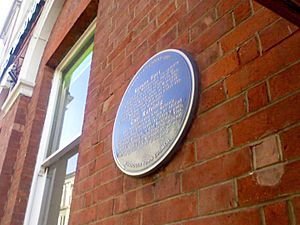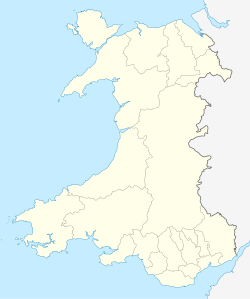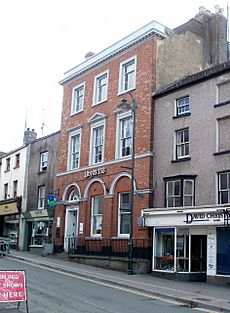Blestium facts for kids

A plaque on Lloyds TSB records the fort's position.
|
|
| Alternative name | Blestio |
|---|---|
| Location | Monmouth, Monmouthshire, Wales, United Kingdom |
| Region | Britannia Superior |
| Coordinates | 51°48′32″N 02°43′01″W / 51.80889°N 2.71694°W |
| Type | Settlement |
| History | |
| Builder | Publius Ostorius Scapula or Aulus Didius Gallus |
| Founded | Possibly before 55 AD |
| Periods | Roman Imperial |
Blestium (also called Blestio) was a small Roman fort and a place where people worked with iron. It was part of the Roman province of Britannia Superior in Roman Britain. Today, we believe Blestium was located where the town of Monmouth in south east Wales now stands. It was right where the River Monnow meets the River Wye. A special plaque in Monmouth shows where the old fort used to be.
Discovering Blestium's Past
The only old Roman record that mentions Blestio is found in a travel guide called the Antonine Itinerary. This guide listed important Roman roads and towns. Blestium was on a road between two big Roman towns: Caerleon (called Isca Silurum) and Silchester (called Calleva Atrebatum).
It was located halfway between the fort at Usk (Burrium) and an iron-making area called Ariconium. Ariconium is thought to be near Ross-on-Wye today. The name Blestium might come from a Greek word, blastos, which means "offshoot."
Experts now agree that a Roman military fort was built in Monmouth. This happened around 55 AD, or even earlier. This makes it one of the very first Roman forts in Wales. Roman generals like Publius Ostorius Scapula or Aulus Didius Gallus likely built it. They were leading the Roman army against a local tribe called the Silures.
The Silures lived in south east Wales. The Romans built many small forts along the River Monnow valley. They also moved towards Usk, where they built the fort of Burrium. The Silures fought bravely against the Romans for about 30 years. They used guerrilla warfare, which means small groups fighting with surprise attacks. Eventually, the Romans, led by Sextus Julius Frontinus, defeated them.
The fort at Blestium probably held about 2,000 soldiers when the Romans first invaded. Later, it became a smaller fort.
What We've Found at Blestium
For a long time, not many Roman things were found in Monmouth. But in 2007, the Monmouth Archaeological Society made an exciting discovery. They found the first ditch of the old Roman fort. It was behind some buildings on Monnow Street, right in the middle of Monmouth.
In 2010, more digging in Agincourt Square uncovered Roman pottery and bones. These finds helped prove that a fort really existed there.
There's also a lot of evidence that Romans worked with iron in Blestium. They used local iron ore (rock with iron in it) and charcoal from nearby forests. They heated these materials in special ovens called smelting hearths to get the iron out. You can find remains of these hearths and waste material called slag in the town centre and in the Overmonnow area.
Stone buildings from the 2nd and 3rd centuries, linked to iron working, have been found near the River Monnow. Roman coins from the 3rd and 4th centuries have also been discovered. This suggests that people continued to live in Blestium even after the fort became smaller.
Monmouth Heritage Trail
The Monmouth Heritage Trail is a path that helps you explore the town's history. It includes a special blue plaque that tells you about the Roman fort of Blestium. This plaque is on a building that is now a Lloyds TSB bank on Monnow Street.
This building is quite old, built in the late 1700s. A man named Philip Meakins Hardwick, who helped start a local club, probably built it. Famous people have visited this house. For example, Viscount Nelson, a famous British admiral, was entertained there in 1802. Another person who lived there was an architect named Philip Fisher. He designed improvements for the Shire Hall, Monmouth in the 1720s. This building is now a Grade II listed building, which means it's a historic building protected by law.




